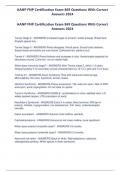AANP FNP Certification Exam 869 Questions With Correct
Answers 2024
AANP FNP Certification Exam 869 Questions With Correct
Answers 2024
Tanner Stage 2 - ANSWERS-Increased rugae of scrotum, testes enlarge. Breast bud.
Straight sparse hair.
Tanner Stage 3 - ANSWERS-Penis elongates. Pencil penis. Scrotal color darkens.
Breast tissue and areola are one mound. Darkened hair, starts to curl.
Tanner 4 - ANSWERS-Penis thickens and increases in size. Areola/nipple separate for
secondary mound. Curly hair, not on medial thigh.
When does menarche begin? - ANSWERS-After Tanner stage 2, within 1-2 years.
Delayed puberty if no secondary sexual characteristics by 12-13 in girls and 14 in boys.
Trisomy 21 - ANSWERS-Down Syndrome. Risk with advanced maternal age.
Microcephaly, flat nose, hypotonia, simian crease.
Marfan's Syndrome - ANSWERS-Pectus excavatum. Tall, wide arm span. Risk of MVP,
aneurysm, aortic regurgitation. Do not clear for sports.
Turner's Syndrome - ANSWERS-FEMALE. Lymphedema in utero, webbed neck, LD,
widely spaced nipples, HTN coarctation of aorta.
Klienfelter's Syndrome - ANSWERS-Extra X in males. More feminine. Will see in
puberty. Infertile, hypogonadism, low testosterone. Tall, lanky, underdeveloped
sexually.
Caput succadeum - ANSWERS-Sutures cross midline, spreads.
Caphalohematoma - ANSWERS-Sutures do not cross midline, more significant.
When does anterior fontanelle close? - ANSWERS-18 months
When does posterior fontanelle close? - ANSWERS-2-3 months
Abrnomal red reflex - ANSWERS-Black or white. Retinoblastoma, cataracts,
osteogenesis perfecta. White specks in down syndrome.
, AANP FNP Certification Exam 869 Questions With Correct
Answers 2024
Edward's Syndrome - ANSWERS-Trisomy 18. Small mouth. High pitched cry.
Newborn screening tests - ANSWERS-PKU (phenylalanine), can lead to hyperactivity
and mental retardation. Hypothyroid. If not treated, mental retardation. Sickle cell.
Galactessemia, maple smell to urine, septic.
Hordeolum - ANSWERS-Stye. Pain, edema. Bacitracin ophthalmic ointment.
STD conjunctivitis. - ANSWERS-Emergency. Rocephin for gonorrhea.
Gonococcola Ophthamlia Neonatorum - ANSWERS-2-4 days after birth. Red eye,
purulent discharge, swollen eyelids. GC culture, Thayer Martin, ROCEPHIN.
Chalmydial Ophthalmia Trachoma - ANSWERS-4-10 days after birth. Edematous, red,
profuse WATERY discharge that becomes purulent. Azithromycin, erythmocycin.
Otitis externa - ANSWERS-Fungal. Odor, black specks. Clotramizole. Pain with
tragus/pinna. Corticosporin
Sensorineuro hearing loss in PEDS - ANSWERS-Syphilis, acoustic neuroma,
aminoglycoside (gentamycin)
Epiglottitis - ANSWERS-Bacterial. Thumb sign on x-ray.
Croup - ANSWERS-Viral. Steeple sign on x-ray.
Bronchioloitis - ANSWERS-RSV, adenovirus. Under 3. Lower respi. URI, fever, nasal
flaring, stridor.If a preemie, synegis.
Intermittent Asthma peds - ANSWERS-SABA, 2 puffs q 4-6 hours. Peak 30 min-2
hours, lasts 4-6.
S. pneumonia (CAP) peds - ANSWERS-Lobar consolidation. Tx with penicillin.
H. influenza pneumonia peds - ANSWERS-Lobar consolidation. Amoxicillin or
cephalosporin.
M. cataralis or mycoplasma - ANSWERS-Linear. Azithromycin.
, AANP FNP Certification Exam 869 Questions With Correct
Answers 2024
Neurofibromatosis - ANSWERS-Cafe au lait spots. Neurofibromas. Eye nodules.
Freckling.
Peds IDA - ANSWERS-Slow GI loss, too much whole milk. PICA. Flat shaped nails.
Ferritin low. 6-9 month treatments. 3-6 mg/kg day of iron
Thalassemia peds - ANSWERS-Asymptomatic. Enlarged spleen, tachypnea,
tachycardia, prominence in facial bones. TIBC not increased . Electrophoresis.
Sickle Cell Peds - ANSWERS-Vasocclusive crisis. Symptoms in stress, heat,
overexerting. Howel Jolly Bodies. Reticulocytosis. Hydrate, oxygenate, pain
managemnet.
Hemophilia - ANSWERS-Factor VIII. Mother/daughter carry gene but presents in males.
Bleed into joints.
Lead Poisoning - ANSWERS-Over 10 refer. IDA. Butonion line, gingival border. Kelation
therapy.
Leukemia peds - ANSWERS-Chronically tired, pale, resp. infections. Blast cells,
peripheral smear, WBC
HIV testing - ANSWERS-ELISA in older child. PCR in infant. Western blot confirms.
More than 800 CD4 count normal, viral load less than 5000 or 0/undetectable.
Cause of fever in less than 2 month old - ANSWERS-Group B strep, e coli
common cause of fever in 2 months and up - ANSWERS-Strep. pneumoniae, and h.
influenza
Preoperational phase, preconceptual - ANSWERS-2-4 years old
Causation, intuitive - ANSWERS-4-7 years old
When is vision 20/20? - ANSWERS-Age 6
Concrete thinking, cognitive tasks, capable - ANSWERS-School age
What can be confused as child abuse in younger children? - ANSWERS-Osteogenesis
imperfecta or Mongolian spot
, AANP FNP Certification Exam 869 Questions With Correct
Answers 2024
VSD - ANSWERS-Thrill sometimes felt at LL sternal border. Most common heart defect
in babies. Opening between septum. Holosystolic murmur.
Transposition of great arteries - ANSWERS-RVH. L. lower sternal border. Egg on a
string on x-ray.
Tetralogy of fallot - ANSWERS-VSD. Pulmonary stenosis. Overriding aorta. R. sided
hypertrophy. Systolic ejection murmur and thrill. Squat to slow return of blood to heart.
Aortic stenosis - ANSWERS-Systolic thrill. R. upper sternal border. Ejection click heard
at apex. LVH. X-ray, severe HF. More common in boys than girls, common to see mild
exercise intolerance
Coarctation of aorta - ANSWERS-Ejection murmur heard best at LUSB and L
interscapular area. RVH to LVH. Rib notching. Pressures different in upper and lower
extremities.
OFten seen with mitral regurgitation and Aortic stenosis
Still's Murmur - ANSWERS-1-3/6, early systolic ejection murmur. Musical / vibratory
(buzz). Left lower sternal border. Turbulence in left ventricle. Innocents. Softens with
standing, Valsalva, sitting. Age 2-6 years
Hemic murmur - ANSWERS-Mild systolic ejection murmur, high-pitched, pulmonic &
aortic areas.
Only heard in increased cardiac output.
Venous hum - ANSWERS-Heard best while sitting, disappears while supine. R and L
upper sternal border, continuous humming murmur. innocent. Disappears in supine
position or when jugular vein compressed. > 3yo
PDA (patent ductus arteriosus) - ANSWERS-2-4/6 continuous heard best over LUSB.
Full pulses. Most common congenital heart defect. More common in girls
MVP - ANSWERS-1-3/6 mid-systolic click w/ late systolic murmur. Heard best at apex.
Louder with standing/squatting. Often seen with pectus excavatum
Pulmonic valve stenosis - ANSWERS-2-5/6 best at LUSB, ejection click @ 2nd L ICS.
Radiates to back.
May involve wide S2. Usually d/t fusion of valves
HTN in peds - ANSWERS-Organ problem or aldosterone. Cushings. Refer to cards




